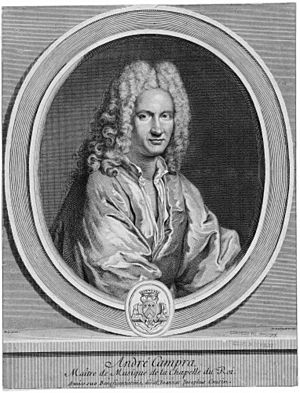André Campra facts for kids
André Campra (baptized 4 December 1660 – 29 June 1744) was a famous French composer and conductor from the Baroque era. This was a time when music was very grand and decorative. Campra was one of the most important French opera composers between two other famous musicians, Jean-Baptiste Lully and Jean-Philippe Rameau. He wrote many popular operas, including tragédies en musique (musical tragedies) and opéra-ballets (opera-ballets). He also composed religious music, like a requiem, and special songs called cantatas.
Biography
André Campra was born in Aix-en-Provence, France. His father, Giovanni Francesco Campra, was a surgeon and violinist from Italy. His mother was Louise Fabry. André's father was his first music teacher. He was baptized on December 4, 1660, in a church called Église de la Madeleine.
In 1674, when he was about 14, André became a choirboy at the Cathédrale Saint-Sauveur. Four years later, he started studying to become a priest. In 1681, his bosses weren't happy because he took part in plays without asking for permission. Even so, he became a chaplain on May 27 of that year.
Campra worked as a maître de musique (music director) at cathedrals in Arles and Toulouse. From 1694 to 1700, he was the music director at the famous Notre-Dame de Paris cathedral. At Notre-Dame, Campra did something new: he added violins to sacred music performances. This was a bit controversial because violins were often seen as instruments for street music back then.
In 1697, he started writing music for the theater. To protect his good name with the church, he published some of his theater music under his brother's name. By 1700, he left his job at Notre-Dame to focus completely on theater music. His theatrical works were very successful. By 1705, he was so famous that he even became a target for negative articles in newspapers. In 1720, he decided to make sacred music his only job again.
Even though Campra was very successful, he didn't always have a lot of money. In 1722, he worked briefly for the Prince of Conti as a music director. After a royal leader named Philippe d'Orléans died in 1723, Campra got a job at the Royal Chapel in Versailles. In 1730, he became the Inspecteur Général (General Inspector) at the Royal Academy of Music, which was a big opera house.
André Campra passed away in Versailles on June 29, 1744. He was 83 years old.
Compositions and Style
Campra became very well-known for his opéra-ballet works. This type of musical show combined opera with ballet. He became highly regarded in this style after composing L'Europe galante in 1697. Another composer, Pascal Colasse, had started this musical style a few years earlier.
Principal works
Stage works
- L'Europe galante, opéra-ballet (1697)
- Le carnaval de Venise, opéra-ballet (1699)
- Hésione, tragédie en musique (1700)
- Aréthuse, opéra-ballet (1701)
- Tancrède, tragédie en musique (1702)
- Les muses, opéra-ballet (1703)
- Iphigénie en Tauride, tragédie en musique (1704)
- Télémaque, tragédie en musique pastiche (1704)
- Alcine, tragédie en musique (1705)
- Hippodamie, tragédie en musique (1708)
- Les fêtes vénitiennes, opéra-ballet (1710)
- Idoménée, tragédie en musique (1712)
- Télèphe, tragédie en musique (1713)
- Énée et Didon, fête musicale (1714)
- Camille, reine des volsques, tragédie en musique (1717)
- Les âges, opéra-ballet (1718)
- Achille et Déidamie, tragédie en musique (1735)
Cantatas
- Book I 1708 – Hebe. L'Heureux jaloux. Didon. Daphne. Arion. Les femmes.
- Book III 1728 – L'heureux moment, Les caprices de l'Amour, La colère d'Achille, Les plaisirs de la campagne, Le papillon, Le jaloux, Le lys et la rose
Sacred works
- Nisi Dominus (1722)
- Requiem (after 1723)
- Motets for the royal chapel (1723–1741)
- Te Deum
Legacy
- A composer named Darius Milhaud used some of Campra's themes in his 1936 orchestral work called Suite provençale.
- A theme from Campra's opera Camille, reine des Volsques (1717) was used in a special project in 1952. Seven French composers worked together to create variations on this theme, calling it La guirlande de Campra.
- The "Rigaudon" from his opera Idoménée is probably his most famous piece today. It's often played at weddings and has been recorded many times.
- There is a state-owned secondary school in Aix-en-Provence named Collège Campra after him. It even has a statue of him.
See also
 In Spanish: André Campra para niños
In Spanish: André Campra para niños


